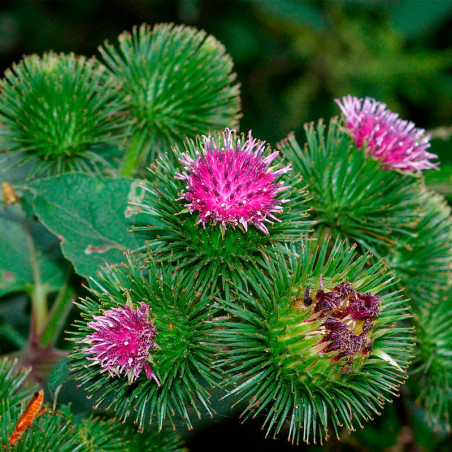







Arctium lappa, commonly known as Greater Burdock, is a perennial plant with robust stems and large leaves, found in damp, sunny areas. Its purple flowers form spiny heads that produce fruits with small hooks, known for sticking easily to clothing or animal fur. Additionally, its roots and leaves are used in the production of cosmetic products and traditional cooking.
Arctium lappa, commonly known as Greater Burdock, is a perennial plant found in damp, sunny soils across Europe, Asia, and North America. It has a robust stature, with erect stems and large, oval-shaped leaves with serrated edges. It can grow up to 2 meters in height, making it an imposing plant in its natural environment.
Historically, Greater Burdock was used as an edible vegetable, particularly its roots, which were cooked in various dishes. The taste of the immature stems is similar to that of artichoke, making it a popular ingredient in cooking. Over time, its consumption declined, but in the 20th century, it regained popularity due to its inclusion in the macrobiotic diet, especially for its health benefits.
In Japan, Arctium lappa is known as Gobo and is widely used in traditional cuisine, where its roots are prepared in soups, stews, and salads. The plant’s purple flowers form globe-like heads surrounded by spiny bracts, while the fruits, with small hooks, easily cling to clothing or animal fur, aiding in its dispersion.
In addition to its culinary uses, Greater Burdock is also valued in cosmetics, with its roots and leaves being used in the production of creams and soaps for their skin benefits. In gardens, it is a hardy plant that adds a rustic, characterful touch, ideal for damp soils and partial shade areas.
| January | February | March | April | May | June | July | August | September | October | November | December |
Data sheet
No customer questions for the moment.